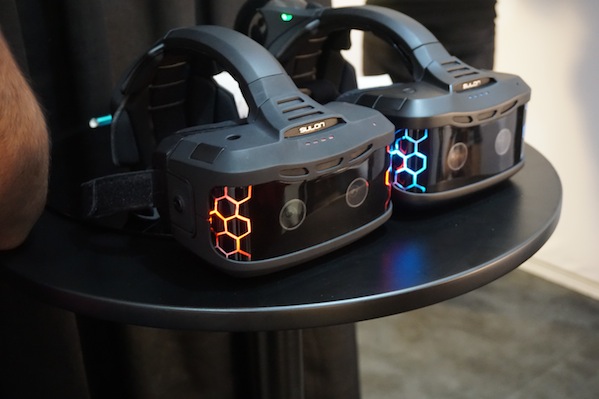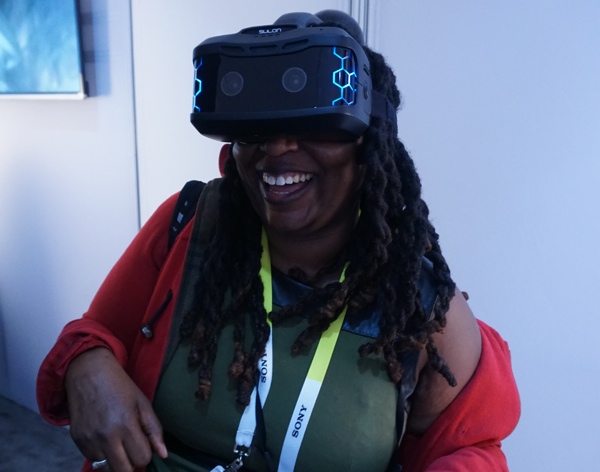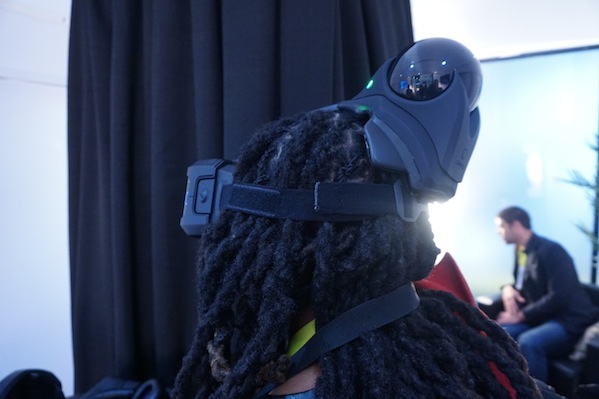Cortex Headset Creates a Personal Holodeck
Combining augmented and virtual reality, the Sulon Cortex creates an entirely different experience.

The world is still waiting for a truly consumer-ready virtual reality headset. While we wait, I've had the opportunity to see quite a few contenders, some with haptics, others with 3D audio. However one of the more interesting devices on the market comes from Sulon Technologies in the form of the Cortex head-mounted display. Available for pre-order at $499, the headset combines VR and augmented reality, creating an interesting new experience.
Design

If the Cortex is any indication, the future will not be fashionable. From the front, the Cortex has a similar rectangular shaped headset as other devices on the market. However the glowing blue lights pulsing in a honeycomb pattern, gives the prototype some panache. The design quickly goes from slick to wacky, thanks to the large shiny globe affixed to the back of headset. I was informed by my editor-in-chief that I looked like an alien invader.
The orb has a role, other than gaudy decoration. It houses a host of sensors that map your surroundings. The more normal looking front of the headset contains a sensor to track your hand movements.
MORE: CES 2015 Day 2: Top 10 Stories
VR Meets AR

According to Sulon Tecnhologies, the Cortex is neither augmented or virtual reality, instead coining the term "augmented virtual reality." Using the ball of sensors on the back of the headset, the Cortex can map the room you're standing in, including walls and furniture and incorporate them into the virtual world you're currently exploring.
Sign up to get the BEST of Tom's Guide direct to your inbox.
Get instant access to breaking news, the hottest reviews, great deals and helpful tips.
For my demo with the Cortex, was tasked with checking out the inner workings of a car engine. Once the program began, there was a life-sized car engine floating in front of me. I placed my hands out in front of me until the front sensors detected them. Represented as a series of dots, I made an opening motion to access an expanded view of the engine. Once the engine was taken apart, I walked around the parts getting a close look at the floating parts.
Walking around the room, looking at the various parts I noticed that the floating objects looked solid. I had to fight the urge to reach out and grab a part several times. The Sulon reps encouraged me to walk toward where the Cortex had rendered a wall. Once I reached one with my hand out, sure enough, it was one of the physical walls in the room.
That's not to say, the device is perfect. It took several attempts to get the front-mounted sensors to register my hands and even then it took a few attempts to perform the motions to expand and contract the engine. I noticed a little bit of lag when the engine was disassembling and reassembling. However since this is a prototype, it was more or less expected. The performance was also marred by the warring cellphone and Wi-Fi signals blanketing the CES show floor.
MORE: CES 2015: Readers' Choice Awards
Software
One of the key differences between similar VR devices and the Cortex is that this headset can run programs stored on the device as well as stream them from the cloud or the cloud. Content can be added to the head-mounted display via a USB port located on the top left corner of the front of the device. We learned that programs rendered by the headset wouldn't have the same quality as those streamed from a PC since a desktop or PC would theoretically have more powerful specs to handle the heavy lifting.
Similar to most VR devices on the market, the Cortex's library of content is rather small. Sulon is hoping to change this by selling the device to interested developers who in turn will create additional content.
Bottom line
The Sulon Cortex is in a class of its own. The prototype doesn't look like anything currently on the market. The use of the rear-mounted orb and the front-mounted sensors adds a new dimension to the VR experience. Mapping and incorporating your physical surroundings can have many use cases with the right program. In a game setting, a couch could be transformed into cover during a shooter or a treasure chest in an adventure title. It can also have practical applications as I learned in the engine simulation. Although the Cortex is in the early stages of development, I look forward to watching its development in the future.
Sherri L. Smith has been cranking out product reviews for Laptopmag.com since 2011. In that time, she's reviewed more than her share of laptops, tablets, smartphones and everything in between. The resident gamer and audio junkie, Sherri was previously a managing editor for Black Web 2.0 and contributed to BET.Com and Popgadget.

